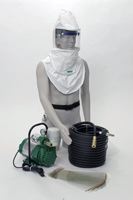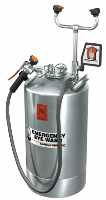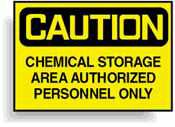 |
 |
| MSDS Topics |
Free Sites | FAQ's | Regulations | Glossary | Software | Suppliers |
| Books | Forum | Poll | Fun stuff | Quiz | Store | |
| MSDS and safety supplies | Search ALL our MSDS info | |||||
 | |||
 |
 |
 |
|
| Title: 02/06/1992 - Acid gas cartridges containing hexavalent chromium. | |
| Record Type: Interpretation | Standard Number: 1910.1200 |
February 6, 1992
MEMORANDUM FOR: R. DAVIS LAYNE, REGIONAL ADMINISTRATOR
THROUGH: LEO CAREY, DIRECTOR, OFFICE OF FIELD PROGRAMS
FROM: PATRICIA K. CLARK, DIRECTOR, DIRECTORATE OF COMPLIANCE PROGRAMS
SUBJECT: Acid Gas Cartridges Containing Hexavalent Chromium and the Hazard Communication Standard
This is in response to your memorandum of February 5, regarding the applicability of the Hazard Communication Standard to acid gas respirator cartridges containing hexavalent chromium. We apologize for the delay in this response.
|
At issue is whether manufacturers of these types of respirator cartridges would have to warn of the (cancer) hazard of exposure to the hexavalent chromium (Cr(VI)) present in these types of cartridges. After carefully reviewing the background information attached to your memo, it was learned that NIOSH found no exposure to particulate Cr(VI) possible after testing several commercially available MSHA/NIOSH certified cartridges. Since no exposure is expected under normal conditions of use, and since, even under abnormal "test" conditions simulated by NIOSH no chromium was detected, the cartridges can be considered to be articles as defined under the HCS and would not be covered under the requirements of the standard. Further, since manufacturers have been notified by NIOSH that acid gas cartridges containing hexavalent chromium would not be approved by NIOSH after September 1, 1990, no new manufacturing of the cartridges can be anticipated, and, therefore, any requirement of the chemical manufacturer to transmit MSDSs and labels to downstream users warning of the potential hazard would not apply. Chemical manufacturers must transmit "significant information" only with the next shipment of hazardous chemicals within three months after they become aware of the new information (29 CFR 1910.1200(g)(5)).
|  Supplied air respirators such as this one from Safety Emporium do not use cartridges. |
We hope this has been responsive to your inquiry. Feel free to contact Melody Sands of my staff if you have any further questions.
February 5, 1991
MEMORANDUM FOR: PATRICIA K. CLARK, DIRECTOR , Directorate of Health Compliance
THRU: LEO CAREY, DIRECTOR, Office of Field Programs
FROM: R. DAVIS LAYNE, Regional Administrator
SUBJECT: Applicability of the Hazard Communication Standard to Acid Gas Cartridges Containing Hexavalent Chromium
|
Technical Support recently became aware that acid gas cartridges had previously contained hexavalent chromium (CrVI) in their sorbent. This was brought to our attention when a telephone inquiry to Technical Support requested an interpretation of the applicability of the hazard communication standard to those acid gas cartridges containing hexavalent chromium. In further research and discussion with NIOSH's respirator certification branch, we learned that NIOSH had issued a letter to all respirator manufacturers stating that as of September 1, 1990, NIOSH would no longer approve acid gas cartridges containing hexavalent chromium. In the same letter NIOSH even though admitting that there was dusting of the cartridges, indicated that the risk of exposure to the user was minimal. On January 30, 1991, Sven Rundman of the Technical Support staff and Melody Sands-Ziegler discussed the applicability of the standard. They concluded that the hazard communication standard was applicable. However, we formally request a written interpretation regarding the applicability of the standard including whether a material safety data sheet would be required. Please respond as soon as possible.
|
 Working at a remote location? Portable eye wash units from Safety Emporium can help meet OSHA requirements. |
If you have any questions, please contact Cynthia P. Wolfe, Assistant Regional Administrator for Technical Support at FTS 257-2281.
Enclosure
LETTER TO ALL RESPIRATOR MANUFACTURERS
June 15, 1990
In our "Letter to all Respirator Manufacturers" dated August 23, 1988, we suggested, "that respirator manufacturers who use chromium-impregnated sorbents in acid-gas cartridges and canisters, seriously consider replacing that sorbent with a chromium-free sorbent." This suggestion was based upon data which confirmed that hexavalent chromium (CrVI) was present in these sorbents. In the present letter, NIOSH is supplying additional information relevant to this subject.
 Encourage proper work habits with safety signs, labels and training from Safety Emporium. |
NIOSH's current published policy states that only the insoluble forms of CrVI are potential human carcinogens (NIOSH Criteria for a Recommended Standard (1973) and NIOSH Criteria for a Recommended Standard (1975)). Since those publications, new scientific evidence has not only demonstrated the carcinogenic activity of soluble CrVI compounds in exposed animals (Glaser et al. 1986; Levy et al. 1986; Steinhoff et al. 1986) but also has shown epidemiological evidence that indicates similar carcinogenicity among workers exposed to soluble CrVI (Blair and Mason 1980; Franchini et al. 1983; Royle 1975; Silverstein et al. 1981; Sorahan et al. 1987). NIOSH has reevaluated its published policy. In its testimony on the Occupational Safety and Health Administration's Proposed Rule on Air Contaminants, 29 CFR 1910, on August 1, 1988, NIOSH recommended that all CrVI compounds be considered potential occupational carcinogens.
|
As noted in the August 23, 1988, letter, the sieve analyses that were performed on charcoal from several NIOSH/MSHA-certified acid-gas cartridges did not yield any detectable levels of CrVI in particles of respirable size. However, analysis of charcoal for CrVI from a sample from the core of these cartridges yielded 2 % to 3 % CrVI by weight. Over the past few years, NIOSH has received four separate complaints from respirator users of dusting of charcoal fines from chemical cartridges or canisters. Thus, a potential for wearer exposure to CrVI exists.
The certification regulation, 30 CFR 11 (11.61(a)), requires that NIOSH not accept respirators for examination, inspection and testing "unless they are designed on sound engineering and scientific principles, constructed of suitable materials and evidence good workmanship." NIOSH, therefore, is no longer accepting respirators which contain chromium-impregnated sorbents.
In addition, 30 CFR 11 (11.62(a)(1)) requires component parts of each respirator be "Designed, constructed, and fitted against creation of any hazard to the wearer." Although no respirable CrVI was detected from the limited number of cartridges that were analyzed, the potential for CrVI exposure to respirator wearers still exists.
Several respirator companies have already submitted chromium-free sorbents. Thus, substitute sorbents exist. NIOSH is therefore requiring that respirator manufacturers who use chromium impregnated sorbents in respirator cartridges and canisters replace these sorbents with non-toxic chromium-free sorbents. NIOSH will offer expedited testing for these submittals. Respirators containing chromium-impregnated sorbents will not be considered approved after September 1, 1990.
Sincerely yours,
Thomas R. Bender, M.D., M.P.H.
Director Division of Safety Research
Date January 25, 1990
From Chief, Certification Branch
Division of Safety Research
Subject Letter to All Respirator Manufacturers
To Gwen Strickland-Cid, Attorney Advisor
Through: Acting Director, DSR A(3) 1/29/90
A number of respirator cartridges contain sorbents impregnated with soluble chromium (Cr)VI compounds. Current NIOSH policy states that only the insoluble forms of CrVI were carcinogenic. NIOSH determined that a potential existed for wearer exposure to CrVI. Therefore, in accordance with the certification regulation, 30 CFR 11, which states "The component parts of each respirator shall be designed, constructed, and fitted against creation of any hazard to the wearer." (11.62(a)(1)), VI-impregnated sorbents with less toxic ones. (See attached Letters To All Respirator Manufacturers dated May 13 and August 23, 1988.)
|
Recently the Certification Branch received a copy of the attached letter from Laurence Reed, DSDTT, to Ms. Karen Blanchard of the EPA. This letter changes NIOSH's current published policy on chromium VI-containing compounds. NIOSH now recommends that all forms of CrVI should be considered carcinogenic. Therefore, NIOSH will not accept any further applications for respirators containing CrVI-impregnated sorbents in accordance with 11.61(a) which states "Respirators will not be accepted by the Institute for examination, inspection and testing unless they are designed on sound engineering and scientific principles, constructed of suitable materials and evidence of good workmanship." In order to protect the respirator wearer, it was decided that NIOSH should require all manufacturers of chemical cartridges and canisters to replace the CrVI-impregnated sorbents with non-toxic materials. Currently, certified chemical cartridge respirators and gas masks containing CrVI sorbent should be decertified. Also, NIOSH should set a date when any respirator using cartridges or canisters containing CrVI should be considered not approved. Our regulations state that "MSHA and the Institute reserve the right to jointly revoke, for cause, any certificate of approval issued pursuant to the provisions of this Part (11.34)." Please review the attached proposed "Letter to All Respirator Manufacturers" for any legal implications.
|  Ensure that your MSDS collection is "readily accessible" with these handy compliance centers from Safety Emporium.
|
Thank you for your assistance in this matter.
Nancy J. Bollinger
Attachments
August 23, 1988
LETTER TO ALL RESPIRATOR MANUFACTURERS
In our "Letter to all Respirator Manufacturers" dated May 13, 1988, we suggested, "that respirator manufacturers who use chromium-impregnated sorbents in acid-gas cartridges, seriously consider replacing that sorbent with a chromium-free sorbent." This suggestion was based upon data which confirmed that hexavalent chromium (CrVI) was in those sorbents. In the present letter, NIOSH is supplying additional information relevant to this subject.
 Warn your employees about workplace hazards and policies with signs, training materials and more from Safety Emporium. |
NIOSH's current published policy states that only the insoluble forms of CrVI are potential human carcinogens (NIOSH 1973, NIOSH 1975). Since those publications, new scientific evidence has not only demonstrated the carcinogenic activity of soluble CrVI compounds in exposed animals (Glasser et el, 1986; Levy et al. 1986; Steinhoff et al. 1986) but also has shown epidemiological evidence that indicates similar carcinogenicity among workers exposed to soluble CrVI (Blair and Masen 1980; Franchini et al. 1983; Royle 1975; Silverstein et al. 1981; Sorahan et al. 1987). Because this evidence may be sufficient to reclassify the soluble CrVI compounds as carcinogens, NIOSH is presently reevaluating its published policy regarding carcinogenicity for all forms of CrVI. As noted in the May 13 letter, the sieve analyses that were performed on charcoal from several NIOSH/MSHA-certified acid-gas cartridges did not yield any detectable levels of CrVI in particles of respirable size. However, analysis of charcoal for CrVI from a sample from the core of these cartridges, yielded 2% to 3% CrVI by weight. Thus, a potential for wearer exposure to CrVI exists.
|
The certification regulation, 30 CFR 11, requires component parts of each respirator be "Designed, constructed, and fitted against creation of any hazard to the wearer." (11.62(a)(1)). Although no respirable CrVI was detected for the limited number of cartridges that were analyzed, the potential for CrVI exposure to respirator wearers still exists. Therefore, NIOSH strongly urges that respirator manufacturers who use chromium impregnated sorbents in respirator cartridges replace these sorbents with chromium-free sorbents. In fact, if NIOSH determines that all CrVI compounds are potential human carcinogens, then NIOSH will require that only less toxic sorbents be used in certified respirator cartridges. NIOSH will offer expedited testing for any manufacturer who makes such a replacement.
Sincerely yours,
Thomas R. Bender, M.D., M.P.H.
Director
LETTER TO ALL RESPIRATOR MANUFACTURERS
May 13, 1988
NIOSH has recently received letters from Mr. James Spencer of Grummen Corporation and from Dr. George S. Benjamin and Ms. Jill Niland of the National Safety Council, expressing concern about potential health effects of particulate sorbents which may migrate out of acid gas respirator cartridges. Their principal concern is the possible presence of hexavalent chromium on the sorbent in these cartridges.
NIOSH has tested several commercially available acid gas cartridges from MSHA/NIOSH-certified respirators. The tests included passing air containing various acid gases through the cartridges, collecting any particulate material released by the cartridges, on filters, and analyzing that particulate for Cr(VI). The analyses showed that the collected particulate material contained less than the limit of detection of Cr(VI) [0.1 ug Cr(VI)]. Sieve analysis was also performed on charcoal from several cartridges. None of the material from this analysis was of respirable size.
Although this is a negative finding, we suggest that respirator manufacturers who use chromium-impregnated sorbents in acid-gas cartridges, seriously consider replacing that sorbent with a chromium-free sorbent. NIOSH will offer expedited testing for any manufacturer who makes such a replacement.
Sincerely yours,
Thomas R. Bender, M.D., M.P.H.
Director
Division of Safety Research
The official, public domain, OSHA version of this document is available at http://www.osha.gov/pls/oshaweb/owadisp.show_document?p_table=INTERPRETATIONS&p_id=20548&p_text_version=FALSE